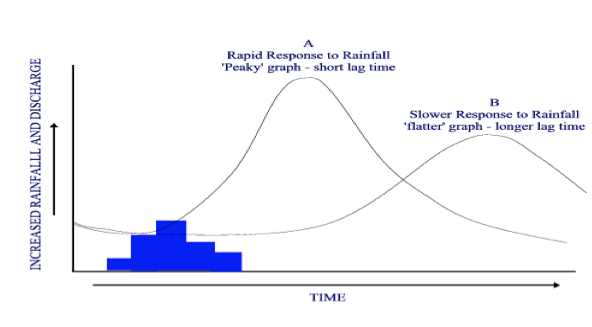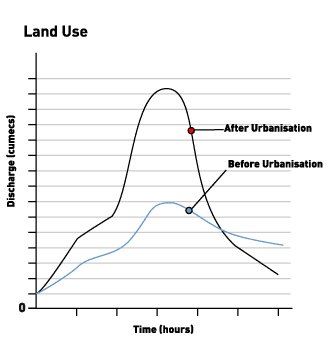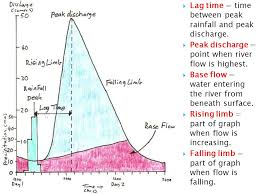Hydrographs
What Is a Hydrograph
Comparing Two Hydrographs
Steeper hydrographs mean more likely to be a storm event or urban area. The lag time is shorter in these storm hydrographs.
Discharge of River
There are a range of physical factors that affect the shape of a storm hydrograph. These include:
- Large drainage basins catch more precipitation so have a higher peak discharge compared to smaller basins. Smaller basins generally have shorter lag times because precipitation does not have as far to travel. The shape of the drainage basin also affects runoff and discharge. Drainage basins that are more circular in shape lead to shorter lag times and a higher peak discharge than those that are long and thin because water has a shorter distance to travel to reach a river.
- Drainage basins with steep sides tend to have shorter lag times than shallower basins. This is because water flows more quickly on the steep slopes down to the river.
- Basins that have many streams (high drainage density) drain more quickly so have a shorter lag time.
- If the drainage basin is already saturated then surface runoff increases due to the reduction in infiltration. Rainwater enters the river quicker, reducing lag times, as surface runoff is faster than baseflow or through flow.
- If the rock type within the river basin is impermeable surface runoff will be higher, throughflow and infiltration will also be reduced meaning a reduction in lag time and an increase in peak discharge.
- If a drainage basin has a significant amount of vegetation this will have a significant affect on a storm hydrograph. Vegetation intercepts precipitation and slows the movement of water into river channels. This increases lag time. Water is also lost due to evaporation and transpiration from the vegetation. This reduces the peak discharge of a river.
- The amount precipitation can have an affect on the storm hydrograph. Heavy storms result in more water entering the drainage basin which results in a higher discharge. The type of precipitation can also have an impact. The lag time is likely to be greater if the precipitation is snow rather than rain. This is because snow takes time to melt before the water enters the river channel. When there is rapid melting of snow the peak discharge could be high.
Human Factors Affecting Storm Hydrographs
There are a range of human factors that affect the shape of a storm hydrograph. These include:
- Drainage systems that have been created by humans lead to a short lag time and high peak discharge as water cannot evaporate or infiltrate into the soil.
- Area that have been urbanised result in an in crease in the use of impermeable building materials. This means infiltration levels decrease and surface runnoff increases. This leads to a short lag time and an increase in peak discharge.
Lag Time
- What is a hydrograph?
- Your answer should include: River / Water / Discharge / Flood
- What impacts on a rivers' discharge?
- Your answer should include: Urbanisation / Discharge / Tributaries / Confluences / High / Drainage / Density / Vegetation
- Explain how a short lag time is created.
- Your answer should include: High / Discharge / Urban / Area / Quick / Fast


